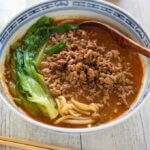
Tantanmen (担々麺) is a Japanese version of Chinese Sichuan Dan Dan Noodles. Unlike Sichuan Dan Dan Noodles, Tantanmen comes with plenty of spicy soup. The topping, i.e., sweet miso-flavoured meat sauce is so tasty. (see the video)
The recipe is based on Iron Chef Chinese, Chen Kenichi’s recipe that was broadcast in the late 1900s.
Prep Time and Cook Time do not include the time required to make chicken broth.
Don't forget to see the section 'MEAL IDEAS' below the recipe card! It gives you a list of dishes that I have already posted and this recipe that can make up a complete meal. I hope it is of help to you.
- 150g/5.3oz fresh egg noodles (or 1 serving dried noodles, note 1)
- 1 tsp pickled mustard plant (榨菜, note 2) finely chopped
- ½ tsp vinegar
- 2 tbsp soy sauce
- 2 tbsp sesame paste (芝麻醤, note 3)
- 2 tbsp rāyu (chilli sesame oil, note 4)
- 2 tbsp green onion finely chopped
- A large pinch of Sichuan pepper (optional)
- 350ml/11.8fl.oz Chinese chicken broth (note 5)
- 150g/5.3oz pork mince
- 1 tbsp oil
- 1 tbsp cooking sake
- 1 tbsp soy sauce
- 1 tbsp sweet soybean paste (甜麺醤, note 6)
- 2 pinches pepper
- 1 stem bok choy vertically quartered and blanched
-
Put all the Spicy Broth ingredients, excluding chicken broth, into a serving bowl.
-
Mix well, ensuring that there are no lumps of the sesame paste (note 7).
-
Add oil to a wok or frying pan over high heat.
-
Add pork mince to the wok/pan and sauté, breaking mince up as much as possible.
-
When the mince has changed to light brown in colour and is almost cooked through, add the rest of the Miso Meat Sauce (Nikumiso) ingredients to the wok/pan.
-
Mix well and continue to cook until the liquid has almost evaporated. Turn the heat off (note 8).
-
Bring a sufficient amount of water in a saucepan to a boil and cook egg noodles as per the instructions on the package of the noodles. Drain the noodles well (note 8).
-
Bring the chicken broth to a boil (note 8).
-
Add the broth to the serving bowl. Mix lightly.
-
Transfer the noodles to the bowl.
-
Put the Nikumiso on top and bok choy pieces on the side.
-
Serve immediately.
1. You can use either dried noodles or fresh noodles. Any medium to thin egg noodles suited for noodle soup are fine. Follow the instructions on the package of the noodles to cook them.
Do not use hokkien noodles as they are oily and suited for stir-frying.
2. It is called ‘zha cai’ or ‘cha tsai’ in Chinese and ‘zāsai’ in Japanese. It has a crunchy texture and a distinct salty flavour. See the photo in the post.
Instead of zāsai, you can use Sichuan preserved mustard greens called ‘sui mi ya cai’ (碎米芽菜) that you can buy at Asian grocery stores. Please refer to Nagi's post, Dan Dan Noodles which explains about sui mi ya cai with a photo.
3. It is a Chinese version of sesame paste. It is called ‘chīmājan’ in Japanese. I also used Carwari brand white sesame paste, which is slightly different from the Chinese version, and it worked well.
Compared to Carwari brand, chīmājan had a stronger roasted sesame flavour and the colour was browner.
Although tahini is also a sesame paste, it lacks a nutty flavour because of the different method of making it. If possible, try to get a Chinese sesame paste as it has the strongest nutty sesame flavour.
4. You can use chilli oil instead. The difference is that rāyu is often made with sesame oil, while chilli oil uses normal oil such as canola oil.
5. It is best to use homemade chicken broth. But as an alternative quick solution, you can use store-bought chicken powder diluted in boiling water.
I tried a Chinese chicken broth powder called 'shantan' (シャンタン), which is made in Japan, as well as Lee Kum Kee brand powder that you can buy from supermarkets (see the photo in the post). Although the powder-based broth was not as rich as the homemade chicken broth, both worked great.
Dilute 2 teaspoons of chicken broth powder in 350ml/11.8fl.oz of boiling water.
The Western-style chicken stock does not suit this dish because it contains other vegetables such as celery and carrots, which change the flavour of the spicy broth.
6. It is called ‘tenmenjan’ in Japanese, but it is a Chinese ingredient commonly used in Northern Chinese cuisine. You can buy sweet soybean paste at Asian grocery stores as well as supermarkets. See the photo in the post.
7. When the jar of your sesame paste is left on the shelf for a long time, the clear oil splits from the sesame powder, leaving the powder at the bottom of the jar. You need to mix them well before measuring the sesame paste to make a dish. But the sesame powder is so dense that it is extremely hard to mix it into the oil and you may end up with a few lumps of sesame paste in your bowl.
8. Ideally, Miso Meat Sauce (Nikumiso), egg noodles, and Chicken broth should be hot and ready at the same time. If you have three cooktop burners, this is achievable by timing each component right.
If you have two burners, you can make Nikumiso first, then heat it up when one burner becomes available. It doesn’t take long to heat it up.
If you are using powdered broth, you don’t need three burners. Boil water in a kettle to make a broth.
Noodles should be added to the bowl as soon as they are cooked. Leaving them for a while after being cooked make the noodles soggy and bloated.